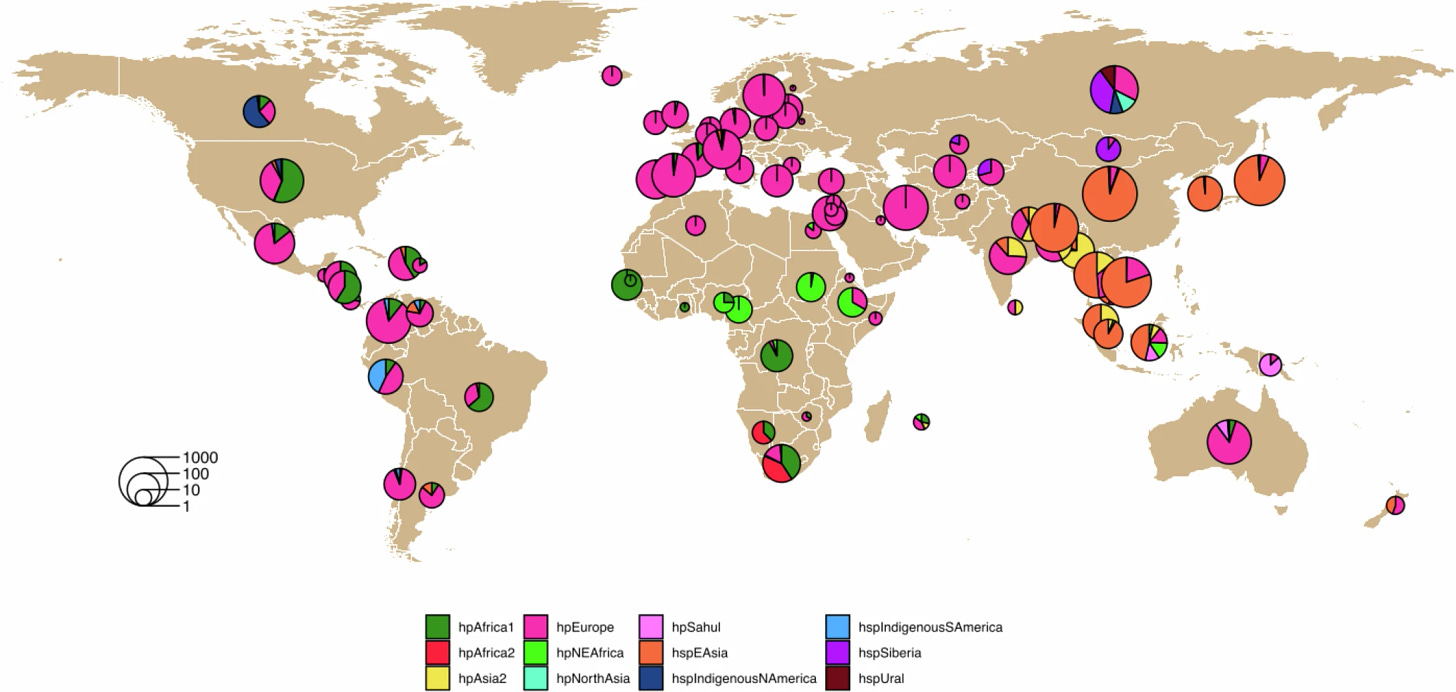The Evolutionary History of Helicobacter pylori and Its Ecospecies with Humans
Manage episode 446926689 series 3444207
A recent groundbreaking study1 in Nature reveals that two distinct types of Helicobacter pylori bacteria—called Hardy and Ubiquitous—have coexisted in the human stomach for over 200,000 years. This research shows that these bacteria not only survived but evolved alongside early humans as they migrated out of Africa, offering new insights into our species' diet and adaptation to different environments.
Understanding Helicobacter pylori
Helicobacter pylori is a bacterium responsible for long-term infections in the human stomach, often leading to ulcers and even gastric cancer. It was first discovered in 1983 and has since been extensively studied for its pathogenic effects and genetic diversity. What makes this bacterium particularly interesting to anthropologists and archaeologists is its deep evolutionary connection with humans, predating their migration from Africa.

Through analysis of over 6,800 genomes from this bacterium, scientists identified two distinct groups or "ecospecies": the widespread Ubiquitous type and the lesser-known Hardy type. These two ecospecies have been shaped by environmental and dietary factors over millennia, offering critical insights into early human survival and diet.
The Evolution of Two Ecospecies
The newly identified Hardy ecospecies, as explained by Dr. Elise Tourette from the Shanghai Institute of Immunity and Infection, arose hundreds of thousands of years ago. It appears specialized to thrive in the stomachs of humans whose diets were predominantly carnivorous, relying on meat or fish for sustenance. This contrasts with the Ubiquitous ecospecies, found in human populations worldwide regardless of their primary food sources.
According to Dr. Daniel Falush, also from the Shanghai Institute, the Hardy ecospecies has only been found in indigenous populations from regions like Siberia and Northern Canada, areas where plant-based food sources were scarce, and diets relied heavily on meat and fish. This pattern implies that early humans in these regions may have had diets largely devoid of plant material, even when plant matter was available.
What These Bacteria Reveal About Early Human Diets
The presence of two distinct ecospecies provides vital clues about the diets of early humans. The Hardy ecospecies, in particular, supports the hypothesis that many of our ancestors were carnivores, particularly in regions where plant food was not available year-round. Its limited presence today in indigenous populations also suggests that it may have gone extinct in many regions, possibly replaced by its Ubiquitous counterpart in populations with more varied diets.
Furthermore, the research sheds light on the adaptability of Helicobacter pylori and how this bacterium has evolved alongside humans. The fact that the Hardy ecospecies still survives in isolated populations and in animals such as tigers and cheetahs due to ancient host jumps underscores the complex evolutionary dynamics at play. Dr. Tourette said,
“The Hardy ecospecies turns out to be exceptionally informative about what the bacteria need to do to survive in our stomach.”
The Implications of This Research for Human Evolution
This study reveals much more than the evolutionary history of a bacterial pathogen. By analyzing the genomes of Helicobacter pylori, researchers can infer patterns of human migration, diet, and environmental adaptation. The finding that both the Hardy and Ubiquitous ecospecies were present in the earliest human populations that left Africa offers new perspectives on how humans interacted with their environment and each other during those migrations.
The Hardy ecospecies not only informs us about the human diet but also suggests that early human populations faced significant challenges related to food availability. Its survival in populations heavily reliant on carnivorous diets implies that humans were capable of adapting to highly specialized dietary niches. Dr. Falush explained,
“This association is particularly intriguing because our analysis also implies that both ecospecies accompanied humans since the origin of our species in Africa more than 200,000 years ago. If the ecospecies is indeed adapted to carnivores, then it implies that the humans that spread out across the world often did not eat much plant matter, even when it was available to them.”
Unanswered Questions and Future Research
While this study provides fascinating insights, it also raises many question:
Why did the Hardy ecospecies survive in only a few isolated populations?
What role did environmental factors play in its disappearance elsewhere?
And what does this mean for the co-evolution of humans and bacteria?
Understanding how these two distinct types of Helicobacter pylori coexisted and evolved could provide further clues to ancient human behaviors. The researchers noted,
“Our results show that highly distinct adaptive strategies can arise and be maintained stably within bacterial populations, even in the presence of continuous genetic exchange between strains.”
The study highlights the need for further investigation into how bacterial and human evolution are intertwined. As research continues, it could help shed light on the substantial burden of gastric diseases that still affect millions of people today.
Conclusion
The discovery of two Helicobacter pylori ecospecies—Hardy and Ubiquitous—has provided a new lens through which to view early human evolution. By revealing how these bacteria adapted to human hosts and offering insights into the diets and migration patterns of our ancestors, this research helps piece together the broader puzzle of human history. As scientists continue to analyze these bacterial genomes, they may uncover even more about the intricate relationship between humans and their microbial companions over millennia.
Tourrette, E., Torres, R.C., Svensson, S.L. et al. An ancient ecospecies of Helicobacter pylori. Nature (2024). https://doi.org/10.1038/s41586-024-07991-z
9 епізодів




